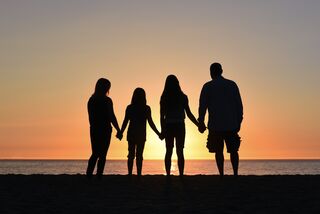Relationships
Rethinking Family for a COVID Holiday
Technologies are allowing us to connect with family—and reconsider it.
Posted November 9, 2020

This Thanksgiving will be very different from years past. Big gatherings are out, and so is travel. In my family, instead of a dozen or more members of our extended clan gathering for a full day of eating and talking, the holiday will likely be limited to our nuclear unit, the same four people (and the same four walls) we’ve been seeing since March. This is what holidays during a pandemic look like, much smaller than we’re used to.
But also, in a sense, bigger. The power of Zoom, Google Meet, Skype, and FaceTime means that we can choose to connect with lots of people on Thanksgiving, even those we wouldn’t normally see. It may mean a close friend keeping you company on a kitchen-counter laptop while you finish up a pie or more time for a call with an uncle across the country. These virtual meets are not the same as our old Thanksgivings, of course, and most of us will be eager for a return to in-person gatherings when we can. But there may be a small silver lining to this imposed distance, an opportunity to include more people and broaden our ideas about who we celebrate with.
I’ve spent the last few years talking to people about how they define family in the context of a technology that challenges those definitions. At least 35 million people worldwide have participated in recreational DNA testing, and many more will buy kits this holiday season amid Black Friday deals or receive them as gifts. The technology allows people to find genetic kin, whether or not they know to look for them. When you test through one of the major companies—AncestryDNA, 23andMe, MyHeritage DNA, and FamilyTreeDNA—you get to see perhaps tens of thousands of relatives who’ve tested at the same company. They may be distant cousins whose names as yet mean nothing to you, or they may be much closer kin.
Consumer genetic testing has been transformational for many groups of people. It has allowed adopted people, otherwise stymied by state laws restricting access to their original birth certificates, to discover the identities of their birth parents. It has given those conceived by purchased sperm the ability to know the men who contributed half their genetic material, as well as any half-siblings conceived by the same donor. It has allowed people to find their way to their biological fathers if they never knew them.
And, in many cases, it has surprised consumers who didn’t even know they had reason to question the identities of their parents by matching them to unexpected relatives. The power of the databases is their size; so many people have tested by now that the person you’re looking for need not be in a database to be identifiable. A cousin match combined with research can be enough to help someone find a parent or sibling.
What does this mean for the American family? One of the themes I explore in The Lost Family: How DNA Testing Is Upending Who We Are is how such relationships force us to think differently about how we define a “father,” for instance. The DNA age hammers home the many different ways in which family is made and forces us to question the notion of the nuclear unit as the standard shape against which all families are measured. Fathers may be forged by biology, or they may be forged by a lifetime of love, nurturing, and experience.
At the same time, many of the countless Americans discovering they’re not genetically related to the parents who raised them can speak to an ineluctable desire—a need, even—to know where their biology comes from and, when possible, to form relationships with their genetic parents. The people I interviewed made clear that their approach to familial relationships is not binary, not a weighing of biological relationships over non-biological ones, with one definition winning out. Each “seeker” of the genetic family decides for him or herself just what relationships to nourish and what terminology to use, but the approach is often inclusive and expansive. It is our language that limits us, not our hearts.
This is a unique moment in which we all have an opportunity to think about the relationships that give us strength—the friend who is as close as a sister, the cousins who double as godparents. What binds us together may be growing up in the same household and shared childhood memories, regardless of how much biology we share. It may be a decades-long friendship forged through shared joy and shared trauma. Or it may be a new relationship with a biological sibling we never knew until adulthood, someone whose affinities and sympathies are uncannily familiar and whose face is like looking into a mirror.
This may be the moment to try to make up for lost time with those new relatives who are really old relatives—if only we’d known they existed. This may be the moment to claim these and other relationships as important, as vital... as family.
We have the opportunity, in this unusual year, to make new rituals, to broaden the pool of people we include in our innermost circle. Who will you be calling this Thanksgiving?


